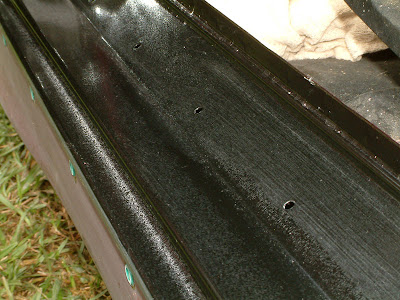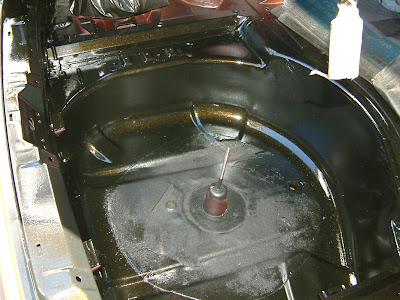Now that the car is clean, masked and in the booth, there are a few more steps I need to carry out before mixing the paint.
Firstly I turned the booth on, so the car's panels have time to warm up. While this is happening I wiped down the car again with a clean lint free cloth. This is followed by another clean with Grease and Wax Remover (aka Prepsol).
Get a lint free cloth and put some Grease and Wax Remover on it and wipe it onto the panels. Then use a separate clean lint free cloth to wipe it off. Do this a panel at a time, and make sure to clean the entire surface which is to be painted. Focus on the parts which have been in contact with hands such as around the door handles, as well as any areas where masking or other any other tape may have been applies.
Following this is the final bit of preparation before painting; wiping the car down with a tack rag. Lightly move the tac rag across the panels where the paint is being applied. Start at the top and work your way down, and remember to turn the tac rag when it gets dirty.
Now it's time to paint... first thing is to remember not to rush, once mixed you have hours complete the job before the paint cures.
The first base coat is a light dust coat, do not try to get coverage of colour with the first coat by applying it heavily. Coverage of the colour will come with the subsequent coats.
Here is an explanation of how I attacked the painting sequence:
1 - Start by running up the A pillar, across the edge of the roof and down the C pillar
2 - Continue on and do the back quarter panel
3 - Do half the boot lid, working from the side you are on to the centre
4 - Do half the roof working from the strip in Step 1 to the centre
5 - Go to the other side and repeat the steps, except by working from the centre of the roof and boot lid out towards the edge of the car
6 - Go back to the first side and work forward from the rear quarter and do the door
7 - Go to the other side and repeat step 6
8 - Go back to the first side and work forward from the door and do the front guard
9 - Go to the other side and repeat step 8
10 - Go back to the first side and do the bonnet, working from the top of front guard towards the centre
11 - Go to the other side and complete the bonnet by working from the centre towards the guard
12 - Spray the front around the lights
I had my front and rear bumpers removed and on stands in the booth, which I would paint once them these steps were done.
Then wait for the paint to flash off and repeat. For me it took four coats of base to get the coverage I wanted.
Obviously this is a rough guide and it can be done other ways. Some people start at the centre of the car roof and work out to the edges. However, people I have spoken to say that you should have a wet edge and work your way around the car by following this edge.
The last coat of base is very important if you are using metallic flake, as I am. Once you are satisfied with the coverage, you will need to 'dust' a coat on which makes the metallic flake 'stand up' and look awesome when the job is done. This dust coat has to be applied lightly and the spray gun has to be further away, so the coat is very dry.
This is how my car looked once my base coats were done.
Once the base coat is ready (check your paint label for the required time), you are ready for the clear coat. This is an important one, apply it too light and it comes out looking dry, apply too heavy and it will run, but get it right and it will make you paint job stand out and look great.
I followed the same painting sequence as I did with the base coat, but with the clear I did one medium-wet coat followed by one coat as wet as I could without getting runs.
Make sure you wait the correct time between clear coats; if you don't wait long enough, the second coat will blend with the first coat and sag, causing runs. If you wait too long, the first coat will dry and the second coat will slide off it, causing, you guessed it, runs. When applying the clear there is a fine balance, but don't let it worry you, just be aware of it.
This is how my car looked once my two clear coats were done... nice!
Now it is the fun part; let the car bake and enjoy a nice cold beer while admiring your handy work.
The following day, I had my car towed back home and here is how it looked in the sun.
Coming up next is colour sanding and polishing to get rid of any imperfections... stay tuned.




































